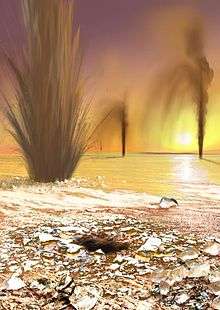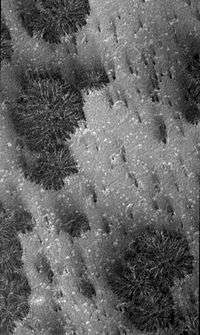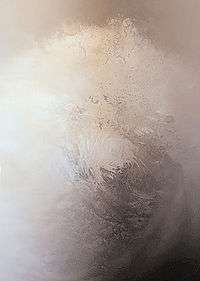Planum Australe
|
Planum Australe, taken by Mars Global Surveyor. | |
| Coordinates | 83°54′S 160°00′E / 83.9°S 160.0°ECoordinates: 83°54′S 160°00′E / 83.9°S 160.0°E |
|---|---|
Planum Australe (Latin: "the southern plain") is the southern polar plain on Mars. It extends southward of roughly 75°S and is centered at 83°54′S 160°00′E / 83.9°S 160.0°E. The geology of this region was to be explored by the failed NASA mission Mars Polar Lander, which lost contact on entry into the Martian atmosphere.
Ice cap
Planum Australe is partially covered by a permanent polar ice cap composed of frozen water and carbon dioxide about 3 km thick. A seasonal ice cap forms on top of the permanent one during the Martian winter, extending from 60°S southwards. It is, at the height of winter, approximately 1 meter thick.[1] It is possible that the area of this ice cap may be shrinking due to localized climate change.[2] Claims of more planetwide global warming based on imagery, however, ignore temperature data and global datasets. Spacecraft and microwave data indicate global average temperature is, at most, stable,[3][4] and possibly cooling.[5][6][7]

In 1966, Leighton and Murray proposed that the Martian polar caps provided a store of CO2 much larger than the atmospheric reservoir. However it is now thought that both polar caps are made mostly of water ice. Both poles have a thin seasonal covering of CO2, while in addition the southern pole has a permanent residual CO2 cap, about 8 to 10 metres thick, that lies on top of the water ice. Perhaps the key argument that the bulk of the ice is water is that CO2 ice isn't mechanically strong enough to make a 3 km thick ice cap stable over long periods of time.[8] Recent evidence from SHARAD ice penetrating radar has revealed a massive subsurface CO2 ice deposit approximately equal to 80% of the current atmosphere, or 4-5 mbar, stored in Planum Australe.[9]
Data from ESA's Mars Express indicates that there are three main parts to the ice cap. The most reflective part of the ice cap is approximately 85% dry ice and 15% water ice. The second part, where the ice cap forms steep slopes at the boundary with the surrounding plain, is almost exclusively water ice. Finally, the ice cap is surrounded by permafrost fields that extend for tens of kilometres north away from the scarps.[10]
The centre of the permanent ice cap is not located at 90°S but rather approximately 150 kilometres north of the geographical south pole. The presence of two massive impact basins in the western hemisphere - Hellas Planitia and Argyre Planitia - creates an immobile area of low pressure over the permanent ice cap. The resulting weather patterns produce fluffy white snow which has a high albedo. This is in contrast to the black ice that forms in the eastern part of the polar region, which receives little snow.[11]
Features
There are two distinct subregions in Planum Australe - Australe Lingula and Promethei Lingula. It is dissected by canyons Promethei Chasma, Ultimum Chasma, Chasma Australe and Australe Sulci. It is theorised that these canyons were created by katabatic wind.[12] The largest crater in Planum Australe is McMurdo Crater.
Geysers on Mars


The seasonal frosting and defrosting of the southern ice cap results in the formation of spider-like radial channels carved on 1 meter thick ice by sunlight.[13] Then, sublimed CO2 (and probably water) increase pressure in their interior, producing geyser-like eruptions of cold fluids often mixed with dark basaltic sand or mud.[14][15][16][17] This process is rapid, observed happening in the space of a few days, weeks or months, a growth rate rather unusual in geology - especially for Mars. The Mars Geyser Hopper lander is a concept mission that would investigate the geysers of Mars.[18][19]
See also
| Wikinews has related news: Massive ice deposits found on Mars |
- Climate of Mars
- List of plains on Mars
- Martian polar ice caps
- Planum Boreum, the northern polar plain
References
- ↑ Phillips, Tony. "Mars is Melting". Science @ NASA. Retrieved 2006-10-20.
- ↑ Sigurdsson, Steinn. "Global warming on Mars?". RealClimate.org. Retrieved 2006-10-20.
- ↑ Wilson, R.; Richardson, M. (2000). "The Martian Atmosphere During the Viking I Mission, I: Infrared Measurements of Atmospheric Temperatures Revisited". Icarus. 145: 555–579. Bibcode:2000Icar..145..555W. doi:10.1006/icar.2000.6378.
- ↑ Liu, J.; Richardson, M. (August 2003). "An assessment of the global, seasonal, and interannual spacecraft record of Martian climate in the thermal infrared". Journal of Geophysical Research. 108 (8). Bibcode:2003JGRE..108.5089L. doi:10.1029/2002je001921.
- ↑ Clancy, R.; et al. "An intercomparison of ground-based millimeter, MGS TES, and Viking atmospheric temperature measurements: Seasonal and interannual variability of temperatures and dust loading in the global Mars atmosphere". Journal of Geophysical Research. 105 (4): 9553–9571. Bibcode:2000JGR...105.9553C. doi:10.1029/1999je001089.
- ↑ Bell, J.; et al. "Mars Reconnaissance Orbiter Mars Color Imager (MARCI): Instrument Description, Calibration, and Performance". Journal of Geophysical Research. 114 (8). Bibcode:2009JGRE..114.8S92B. doi:10.1029/2008je003315.
- ↑ Bandfield, J.; et al. (2013). "Radiometric Comparison of Mars Climate Sounder and Thermal Emission Spectrometer Measurements". Icarus. 225: 28–39. Bibcode:2013Icar..225...28B. doi:10.1016/j.icarus.2013.03.007.
- ↑ Byrne, Shane; Ingersoll, AP (14 February 2003). "A Sublimation Model for Martian South Polar Ice Features". Science. 299 (5609): 1051–1053. Bibcode:2003Sci...299.1051B. doi:10.1126/science.1080148. PMID 12586939.
- ↑ Philips, R. J. et. al (2011). "Onset and migration of spiral troughs on Mars revealed by orbital radar". Science. 332 (13): 838–841. Bibcode:2011Sci...332..838P. doi:10.1126/science.1203091.
- ↑ "Water at Martian south pole". European Space Agency. Retrieved 2006-10-22.
- ↑ "Mars' South Pole mystery". Spaceflight Now. Retrieved 2006-10-26.
- ↑ Kolb, Eric J.; Tanaka, Kenneth L. (2006). "Accumulation and erosion of south polar layered deposits in the Promethei Lingula region, Planum Australe, Mars". The Mars Journal. Mars Informatics Inc. 2: 1–9. Bibcode:2006Mars....2....1K. doi:10.1555/mars.2006.0001.
- ↑ Mangold, N. 2011. Ice sublimation as a geomorphic process: A planetary perspective. Geomorphology. 126:1-17.
- ↑ "NASA Findings Suggest Jets Bursting From Martian Ice Cap". Jet Propulsion Laboratory. NASA. August 16, 2006. Retrieved 2009-08-11.
- ↑ Kieffer, H. H. (2000). ANNUAL PUNCTUATED CO2 SLAB-ICE AND JETS ON MARS (PDF). Mars Polar Science 2000. Retrieved 2009-09-06.
- ↑ Portyankina, G., ed. (2006). SIMULATIONS OF GEYSER-TYPE ERUPTIONS IN CRYPTIC REGION OF MARTIAN SOUTH (PDF). Fourth Mars Polar Science Conference. Retrieved 2009-08-11.
- ↑ Kieffer, Hugh H.; Christensen, Philip R.; Titus, Timothy N. (30 May 2006). "CO2 jets formed by sublimation beneath translucent slab ice in Mars' seasonal south polar ice cap". Nature. 442 (7104): 793–796. Bibcode:2006Natur.442..793K. doi:10.1038/nature04945. PMID 16915284. Retrieved 2009-09-02.
- ↑ Landis, Geoffrey A.; Oleson, Steven J.; McGuire, Melissa (9 January 2012). "Design Study for a Mars Geyser Hopper". NASA. Retrieved 2012-07-01.
- ↑ Landis, Geoffrey A.; Oleson, Steven J.; McGuire, Melissa (9 January 2012). Design Study for a Mars Geyser Hopper (PDF). 50th AIAA Aerospace Sciences Conference. Glenn Research Center, NASA. AIAA-2012-0631. Retrieved 2012-07-01.
External links
| Wikimedia Commons has media related to Planum Australe. |
- Accumulation and erosion of south polar layered deposits in the Promethei Lingula region, Planum Australe, Mars
- Planum Australe on Google Mars.
- Stratigraphy and Topography of McMurdo Crater area, Planum Australe, Mars
- Topographic maps of the Martian South Pole
- USGS map of Planum Australe
